Dublin Then and Now
Sally Richardson reviews Dublin Then and Now: scenes from a revolutionary city by Louise Jefferson (foreword by Robert Ballagh), Brehon Press, ISBN 1905474083, £9.99/€13.99
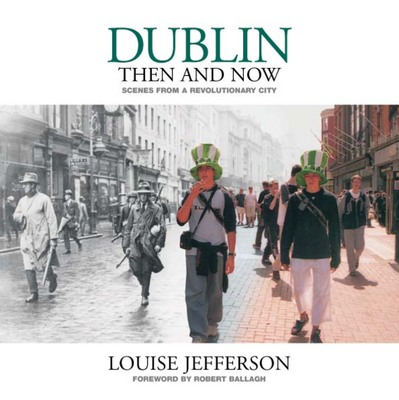
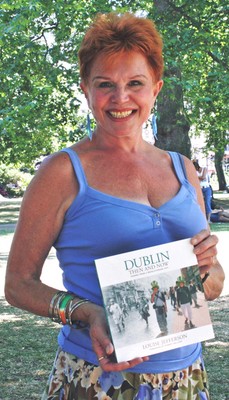
I REMEMBER well the moment a few years ago when Louise Jefferson bounded into the Four Provinces Bookshop with her idea for a book. Old pictures of historical sites in Ireland would be printed alongside her own pictures of the same spot as it is today.
If Louise's idea wasn't entirely original - the 'Then and Now' format has been used before - Louise's approach was entirely different. Her focus was on the way Ireland's revolutionary past has made the difference to the way Dublin looks and feels.
Louise is a professional photographer with many years of experience. Readers may also have seen her pictures in the Irish World.
Louise emigrated to Australia at an early age but has been living in England for a number of years. She has not lost her Aussie accent and, although the Irish Democrat does not usually deal in national stereotypes, she has plenty of Australian chutzpah and her striking appearance, with her red hair and ready smile, mean that once encountered, she is rarely forgotten.
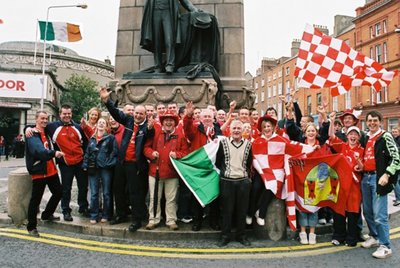
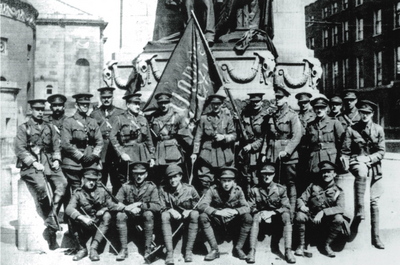
The book came about as a result of Louise's own exploration of her Irish family history. Her grandmother, Molly, was a Dubliner. Ordered out of the country just before the Easter rising when she married a British soldier, the couple made their way to Glasgow where their daughter Eileen - Louise's mother - grew up as a Catholic amid sectarian violence. When Eileen in due course married an English Protestant her husband's family disowned them.
Spurred on by her curiosity about her own origins, Louise found herself gripped by Ireland's historical struggle. The tensions and divisions caused by Britain's involvement in Ireland aroused her sense of injustice and, as her enthusiasm increased, so did her determination to do what she could to explain and support Ireland's cause.
Many trips to Dublin ensued, during which Louise searched out locations of old photographs taken during Ireland's struggle in the years 1916 to 1921 and photographed the same locations as they are now. The old photos show a city at war and under occupation by a foreign power, and Louise wanted to contrast them with images of today's modern, vibrant city.
Louise is a past master at spotting the unusual, the amusing or the picturesque. One particularly striking photograph was taken in Grafton Street, the scene of a well-known photo taken in 1920 of three IRA men. When three young tourists appeared in the same spot wearing comedy St Patrick's Day hats, Louise, who rarely misses her opportunities, had her camera at the ready.
A photographer is sometimes an unobtrusive observer. But some pictures take a little more trouble. Louise managed to marshall a large group of Cork GAA supporters, jubilant after a victorious game, into place around the Parnell monument. The traffic was ready to move and the rain about to come down. Determined to have her picture before they could disperse, she stood in the middle of the road and braved the noise of irate motorists until she had taken it!
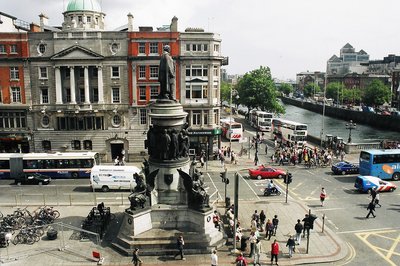
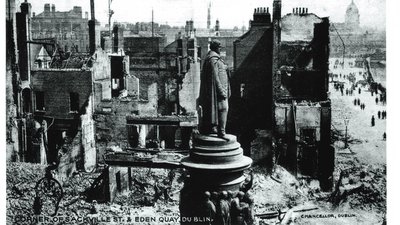
Robert Ballagh, in his thoughtful and reflective Foreword, laments the tearing down of many of Dublin's old buildings and their replacement by office blocks without character or beauty. The new plate glass Liberty Hall on the site of the old one is a striking example. Louise's photo is shown alongside one of the old building, heavily damaged after bombardment by the British, with the banner proclaiming 'James Connolly murdered 12 May 1916'.
However it is remarkable how much of Dublin's infrastructure has been kept in place, though often after heavy restoration and rebuilding. Louise's book shows how many buildings which were gutted and seemingly ruined in 1916 have been restored so thoroughly that few people could guess what they had been through. O'Connell Street, with the Easter Rising headquarters of the General Post Office, looks in many respects just as it did before the British reduced it to rubble.
If the architecture doesn't look very much different, the people who walk, ride and drive through it have altered. (Here one must resist using the phrase "Changed, changed utterly." But it has.)
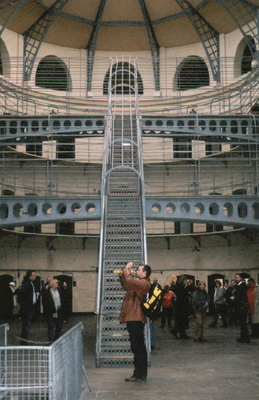
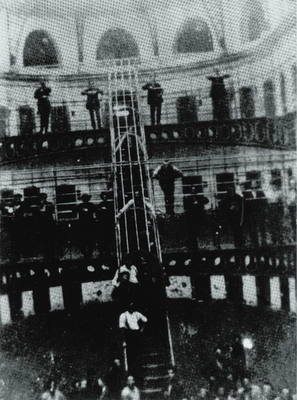
Louise is anxious to stress the political aspects of the book. These are not merely scenic pictures of Dublin's favourite tourist sites. She juxtaposes an image of British soldiers with their disabled army vehicle in College Green in 1921 with her own photo of a Sinn Féin parade with tricolour flags in the same spot; a British armoured car in O'Connell Street is shown alongside a tourist bus and a Japanese tourist replaces a British sentry outside the GPO. There is much wit, humour, and social observation, in Louise's pictures.
Louise likes to visit Ireland as often as she can. Her daughter, the actress Paris Jefferson, has had two triumphs at Dublin's Gate Theatre in the past year, first of all playing the lead role in a highly successful and critically acclaimed revival of W Somerset's Maugham's play The Constant Wife and more recently playing Anna Karenina in another well-received production. Louise had the perfect excuse to spend more time in her favourite city and support her daughter at the same time!
Louise is conscious, however, that Ireland's struggle goes on. She is only too well aware that six of Ireland's counties are still under occupation, and is glad that Paris grew up in Australia, far from the sectarianism that split her own family. She remarks that if Germany and Japan had won World War II and Britain had been occupied, and had had to organize resistance against a brutal enemy, the British perspective might be different. "It's easy to criticize if you haven't been in the situation," she says. This book is her attempt to show what freedom means.
Connolly Association, c/o RMT, Unity House, 39 Chalton Street, London, NW1 1JD
Copyright © 2007 Sally Richardson 2007

